United States’ south-eastern area is one of the richest areas globally in terms of turtle diversity. Florida is among the states with the highest number of turtle species here, with around 30 native species. Among these are terrestrial species but also freshwater turtle species.
So how many freshwater turtles are in Florida?
Florida is home to 13 freshwater turtle species, and they are:
- Southern Painted
- Chicken Turtle
- Spotted Turtle
- Barbour’s Map
- Escambia Map
- Stripped Mud
- Red Eared Slider
- False Map Turtle
- Yellowbelly Slider
- Florida Redbelly
- Florida Cooter
- River Cooter
- Suwannee Cooter
These turtles have similarities, such as all freshwater turtle females lay eggs on land. However, they differ in appearance, size, and reproduction, among other features. Their conservation status also varies, especially because some are categorized as rare and others as endangered species. Let’s look deeper into each of these Florida freshwater turtles.
1. Southern Painted Turtles
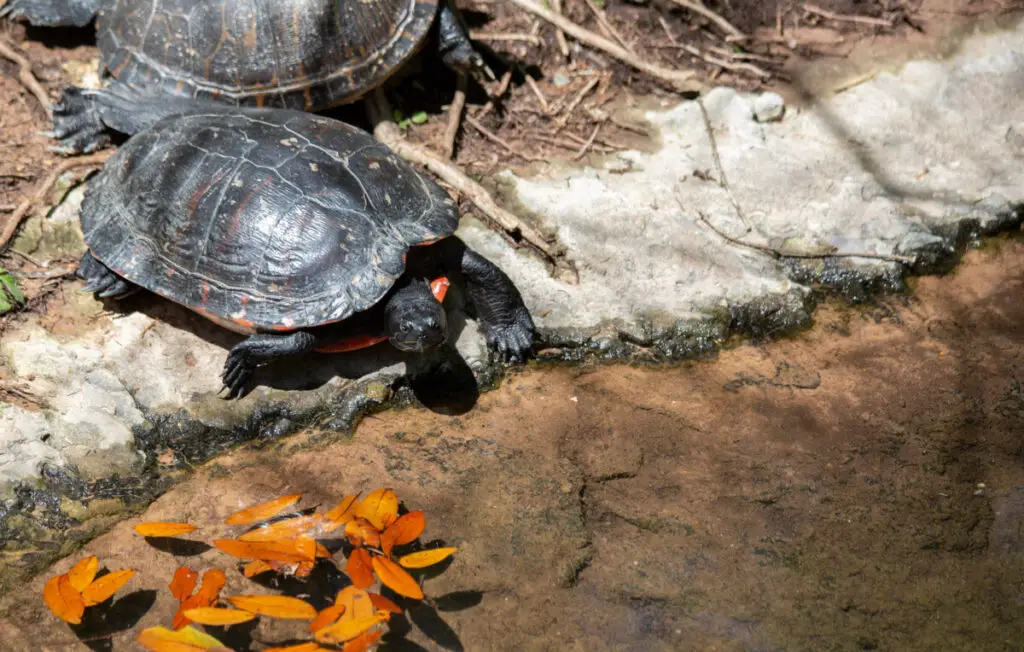
This is one of the most prominent turtles in Florida. It has the scientific name Chrysemys picta dorsalis. The turtle is a subspecies of painted turtles and is a non-native species introduced into this state by owners releasing them into the wild, which should not happen.
These turtles have a distinct visible red line that traverses their shell. The carapace, head, and limbs have yellow jagged or wavy markings that appear to be painted. Its plastron has a dark tan color and is spotless. They grow to a length of 4” to 6” with females being bigger.
Southern painted turtles eat an omnivorous diet. They often feed on algae, snails, fish, and frogs but have a great preference for crayfish and dragonfly larvae. They inhabit shallow waters with soft, muddy bottoms and a lot of aquatic vegetation such as oxbows, wetlands, ponds, rivers, reservoirs, lakes, and ditches.
These painted turtles have a lifespan of around 30 – 40 years in the wild. However, they can survive for longer when in captivity, where they get excellent husbandry and a conducive environment.
A clutch carries an average of 10 eggs. Their eggs stay for between 10 and 12 weeks in incubation.
They are not classified as endangered species in Florida.
2. Chicken Turtle
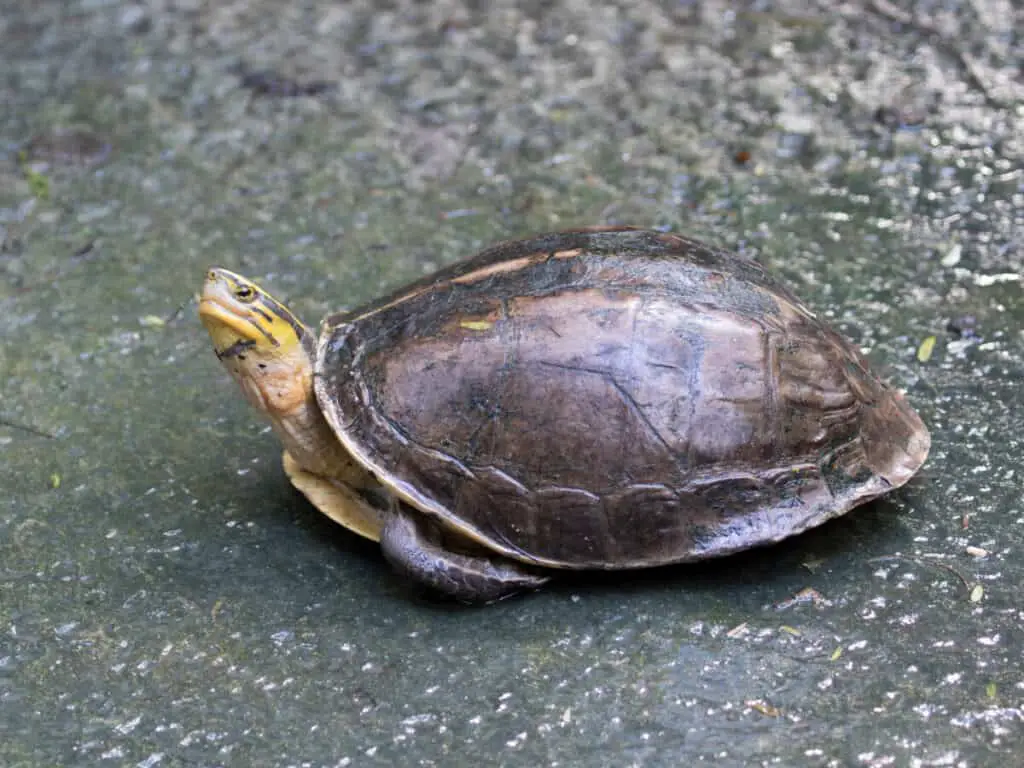
Also known as American Snake-necked, this turtle’s scientific name is Deirochelys reticularia reticularia. In Florida, we have two Chicken turtle subspecies, namely, Florida Chicken and Eastern chicken turtles. They are referred to as chicken turtles because of the taste of their meat. These turtles used to be sold in southern markets.
Florida chicken subspecies have wide yellow and orange patterns, while Eastern chicken turtles have net-like yellow patterns on their green shells. All chicken turtle subspecies have extremely long, striped necks, often measuring the same as their plastron.
Turtles’ size is determined by measuring the length of their upper shell (carapace). This species is moderately sized, growing to 4 to 10 inches, with females often being up to 1.5 times bigger than males.
They prefer flow-moving or stagnant waters such as ponds, marshes, ditches, lakes, Carolina bays, and cypress swamps. In addition, they are fond of habitats with a soft substrate and a lot of aquatic plants. Because they are semi-aquatic, they at times burrow on land or live in forests.
Female chicken turtles reach maturity at five, while males get sexually mature faster at between two and three.
Unlike most turtle species in Florida, chicken turtles nest in either fall or winter. They lay two clutches in a season, preferably on sandy to heavy soils. Each clutch carries about 5 – 15 eggs which remain in incubation for an average of 85 days. Depending on the current warmth conditions, some may overwinter before hatching.
They are turtle species of least conservation concern.
3. Spotted Turtle
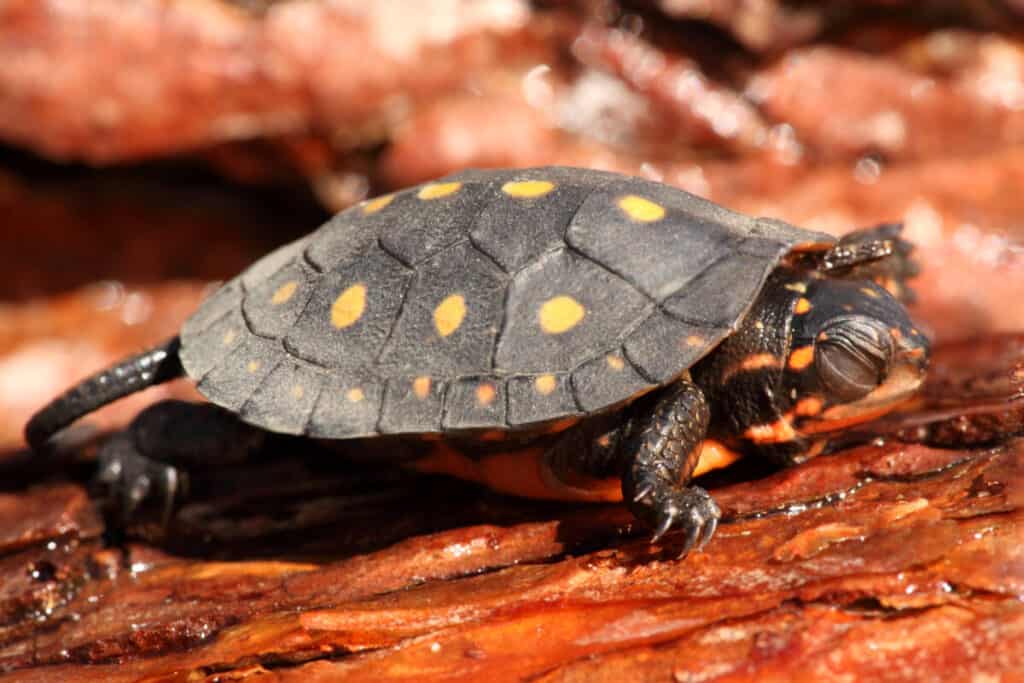
As the name implies, this turtle species has orange, red, or yellow spots on its black carapace and upper part of its skin. In juveniles, these spots are about two but increase in number as the turtle matures. The plastron and lower part of the skin are often orange, red, or yellow and have dark markings.
It bears the scientific name Clemmys guttata.
The spotted turtle hardly grows big, only getting to an upper shell length of between 3 and 4 inches. Their hatchlings measure barely an inch long. The turtle has a relatively long lifespan as it can live for up to 100 years, now that’s long.
They inhabit freshwaters and are often found in bogs, wet meadows, marshes, swamps, and shallow parts of lakes, streams, and ponds. Spotted turtles are omnivores and mainly feed on spiders, slugs, and worms.
Sexual maturity occurs at the age of between 8 and 10. When the nesting season is around, spotted turtles look for dry habitats such as open areas with patches of moss, sandy soils, or pastures. Females lay a maximum of 4 eggs, some of which are eaten by predators. Incubation takes around 11 weeks, after which hatchlings come out and go to wet areas looking for shelter and food.
The spotted turtle population has been declining mainly due to the loss of habitat. Collection of the species for pets due to their beautiful look has also played a role. They are freshwater turtles and are pretty sensitive to toxic substances and pollution. Because of this, spotted turtles’ numbers have also been affected by the reducing water quality.
Spotted turtles are an endangered species in Florida.
4. Barbour’s Map Turtle
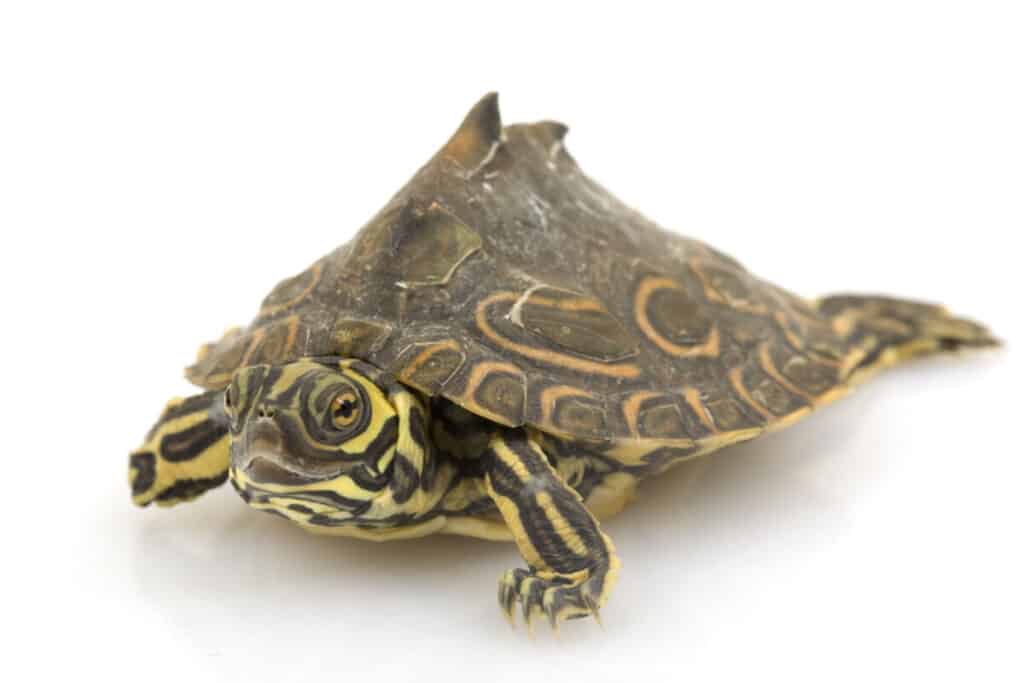
This is the only map turtle species native to Florida. Its biological name is Graptemys barbouri.
They are also the biggest map turtle subspecies getting to a carapace length between 5” and 11”. Females are bigger and can get to 3 times bigger than males. Their shell has an oval shape and gray color with 2 – 4 unique spikes. The plastron of these map turtles is yellow with dark pigmentation. Its skin also has yellow stripes and is often green or black.
Barbour’s map turtles often inhabit deep, fast-flowing freshwater systems and often prefer those with limestone bottoms. They hardly leave water other than during nesting or to bask. Females inhabit deeper waters than males, while baby Barbour’s map turtles live closer to banks.
In Florida, they are found in some Jackson County areas and parts of the Apalachicola River.
This turtle is mainly carnivorous, primarily feeding on snails, insect larvae, insects, mollusks, and amphibians. They have strong beaks that crush mollusks shells. However, males are not fond of snails.
Nesting occurs between June and August. Females lay up to 4 clutches, with each having from 4 to 11 eggs. Hatchlings emerge after around 58 days and head to nearby rivers or streams. They measure 1 inch, and the ratio of males to females depends on the hatching warmth. Warmer conditions give more females.
In Florida, Barbour’s map turtles are threatened species, and it is illegal to possess one.
5. Escambia Map Turtle
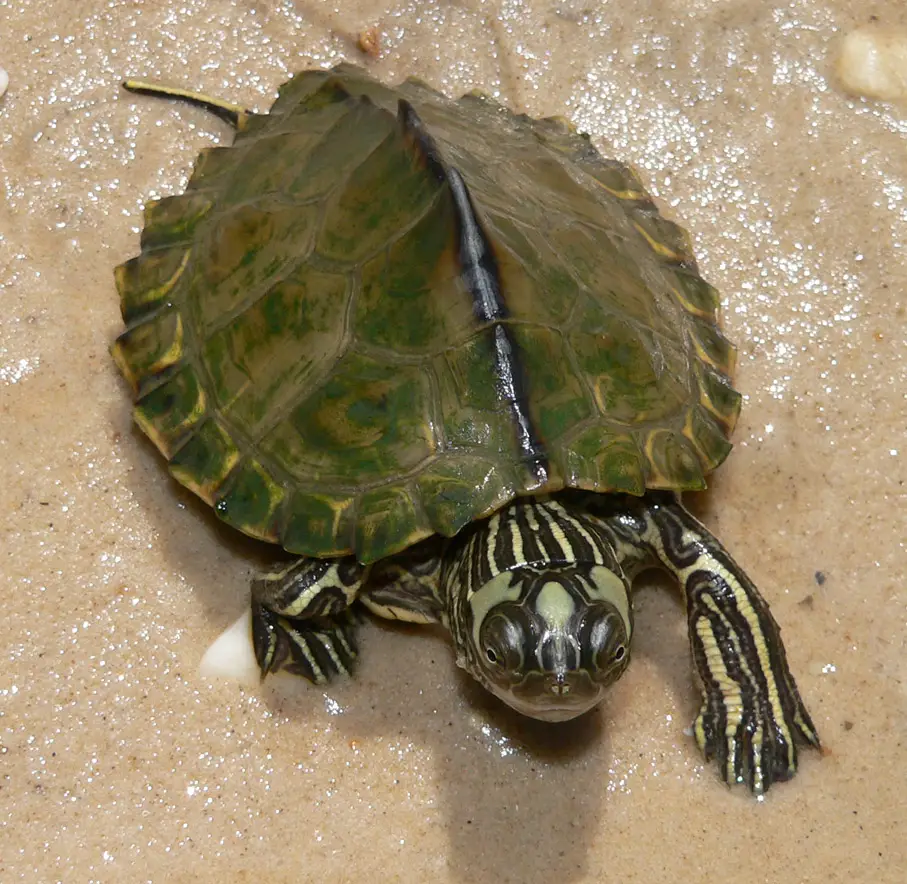
This is a subspecies of map turtles and has the scientific name Graptemys ernsti. They have a brown shell with prominent black vertebral keels. The carapace is highly domed with brown to olive color. The shell’s posterior edge has moderate serration. Their plastron has dark pigmentation around the seams and is yellow.
The head of these map turtles is one of their most distinct features. It has a big interorbital mark connected to other postorbital ones. Their heads also grow considerably big, especially in females. Males also have wider, longer tails.
This species has an expected lifespan of 40 years but can live for longer under favorable conditions.
Escambia male map turtles remain small, only reaching a length of between 3” and 5”. However, females grow significantly big, getting to between 8” and 10”.
As with most map turtles, Escambia subspecies prefer slow-flowing or stagnant waters with abundant vegetation, multiple basking spots, and gravel or sandy bottoms. As such, they are commonly found in lakes, ponds, rivers, and slow-flowing streams.
They feed on an omnivore’s diet and often eat fruits, aquatic vegetation, vegetables, insects, and almost other edible things they come across. They turn to a more carnivorous diet as they age.
Escambia map turtles nest several times a year, often from spring to the end of summer. They prefer nesting areas with partial shading. Sexual maturity is reached when males are around 3” long and females about 8.5”. A clutch carries an average of 7 eggs.
They are species of least concern in Florida.
6. Striped Mud Turtles
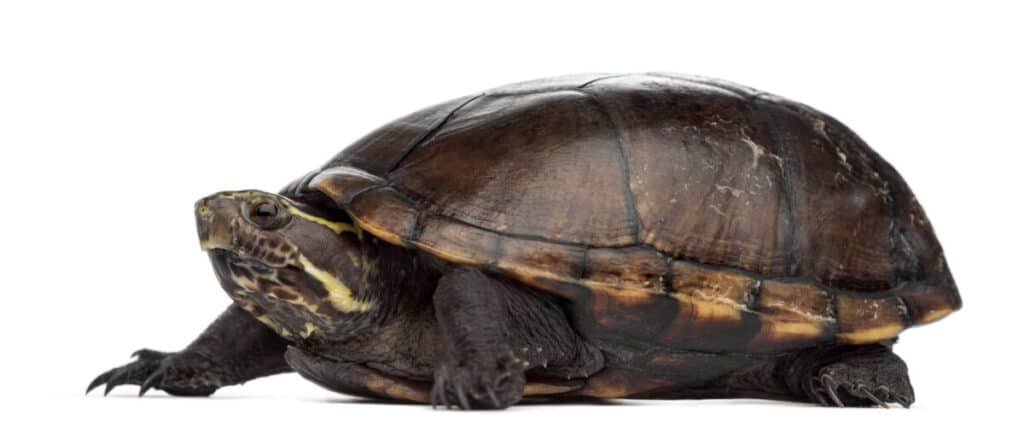
The striped mud turtle is biologically known as Kinosternon baurii. They are the smallest among all mud turtles, only growing to a shell length of 3 – 4 inches. Their shell is oval-shaped, and its upper shell is domed, smooth, and dark brown. Its plastron is double hinged.
Its upper also has three longitudinal stripes traversing the shell, and the stripes are lighter in color than the rest of the body. However, the three lines in some striped mud turtles outside Florida can hardly be seen. The head, eyes, and tips of their nose also have light stripes. Males have longer and thicker tails.
As their name implies, these turtles prefer freshwater, brackish waters, and saltwater habitats with mud or sandy bottoms. As such, they inhabit marshes, swamps, rivers and can also be found in lakes. Because they are semi-aquatic, they can also be found buried in vegetation litter or soil. They can be found all over Florida.
Mud turtles feed on an omnivorous diet, meaning different vegetation types, meat, snails, insects, fish, and fruits.
These mud turtles nest between May and July. They lay eggs multiple times in a year, up to 6, with each clutch carrying between 1 and 6 eggs. Their incubation takes longer than most other turtle species, often lasting between 100 and 110 days.
It is a species of least concern in Florida.
7. Red Eared Slider Turtle

Referred to as Trachemys scripta elegans scientifically, this turtle is identified by the prominent red lines behind the eyes. The stripes at times vary from red to orange and, on rare occasions, yellow. Most turtle owners keep this turtle because of the beautiful appearance though some release them to the wild after some time which is not recommended.
Their carapace is deep olive green and has yellow lines. Its head, limbs, and necks also have a greenish color and yellow lines. The sexes can be distinguished by the concave plastron in males and flat in females.
They have an average lifespan of 25 years but can live for longer under favorable conditions.
These turtles grow to 7 – 12 inches when they mature. They have a preference for fresh and warm waters and can be found in lakes, ponds, slow-moving streams, marshes, and creeks. It is not uncommon to find them in artificial habitats like canals, park ponds/lakes, and ditches.
Red-eared sliders are omnivorous species, and their food includes insects, fish, snails, fruits, vegetables, and aquatic vegetation.
Copulation occurs in waters, and nesting begins in March and continues to the end of July. They can lay eggs up to six nests in a year, depending on the prevailing conditions. They lay eggs on terrestrial nests with a clutch carrying between 2 and 2 eggs. On average, the eggs stay in incubation for 75 days.
Red-eared sliders in Florida are of least concern.
8. False Map Turtle

Also known as saw back turtles because they have pointed protrusions around the back part of their shell, this turtle species has the scientific name Graptemys pseudogeographica. They get the name – false map because of the yellow lines on the upper shell that resemble patterns found in maps. Although the pattern is prominent in their babies, they tend to fade as they age.
Their carapace ranges from olive to brown and also has light yellow marks along the border. On the other hand, the plastron varies from cream to yellow. Further, the limbs and head have light yellow lines with a general body color that ranges from gray-brown to black. Below its chin are light spots.
False map turtles live for an average of 35 years.
This turtle species experience sexual dimorphism, with females growing to almost twice the size of males. Females get to a maximum carapace length of 12 inches, while males get to 6 inches only.
They inhabit major rivers and their tributaries but can also be found in oxbows and backwaters. The turtles spend most of their lives in water, but they can be spotted basking when not in the water.
Copulation occurs both spring and fall, and the females have an average of 15 eggs per clutch. They often nest in burrows in sandy soils. As with most turtles, the temperature determines whether the incubated eggs will yield female or male baby false map turtles.
Although they face the threat of pollution of freshwaters and habitat destruction, they are not considered to be a threatened species.
9. Yellowbelly Slider Turtle
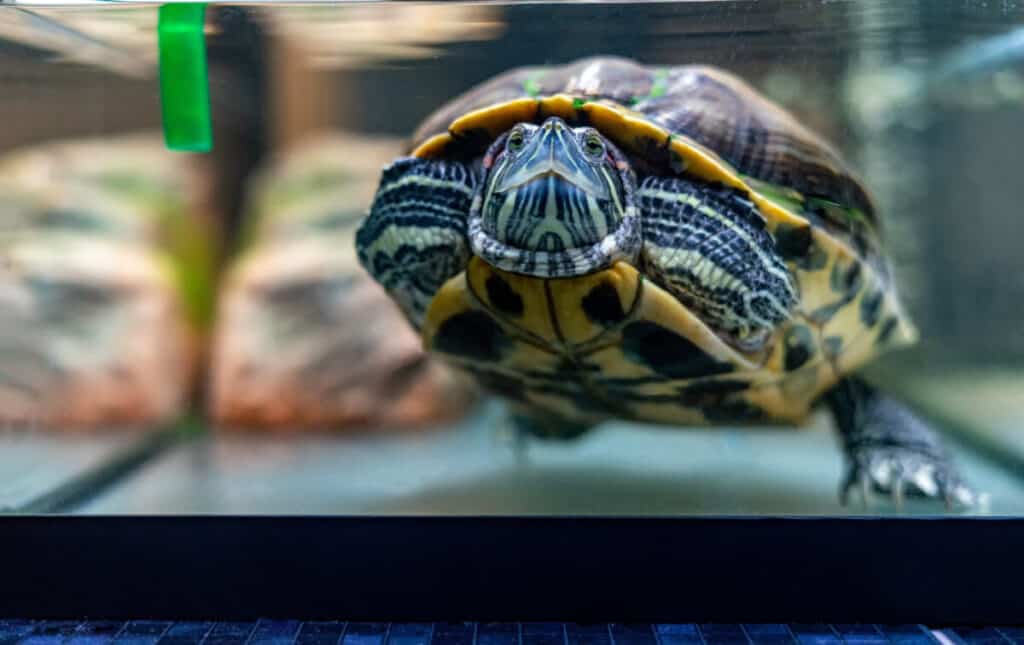
The biological name of the yellowbelly slider is Trachemys scripta scripta. This turtle has a dark carapace with no unique markings, although some have bright yellow marks. Its plastron has black spots and is yellow, thus the name yellowbelly slider turtle. This turtle’s skin is dark, with yellow lines covering it.
Their toes have webbed feet, which makes them good swimmers. Further, the limbs have strong claws to help them grip the soil when they walk towards the land to swim or lay eggs.
This is yet another turtle species that exhibit sexual dimorphism, with the males only growing to a maximum length of 9 inches while females reach 13 inches. Their lifespan ranges between 20 and 40 in the wild.
Yellowbelly sliders are aquatic species often spending most of their time in freshwaters. However, they at times walk on land when moving in between water bodies to bask or lay eggs. Their habitats include swamps, ponds, lakes, sloughs, oxbow lakes, and sinkholes.
These slider turtles are omnivores, but when young, they eat more meat.
Nesting starts from the beginning of spring and often lasts until the end of summer. Their eggs are oval-shaped and have a slightly leathery feel. They lay an average of 8 – 10 eggs which remain in incubation for an average of 75 days. These turtles can lay up to 3 clutches in a season. Their hatchlings emerge measuring 1” – 1.5”.
The turtle is of the least concern in Florida.
10. Florida Redbelly Turtle
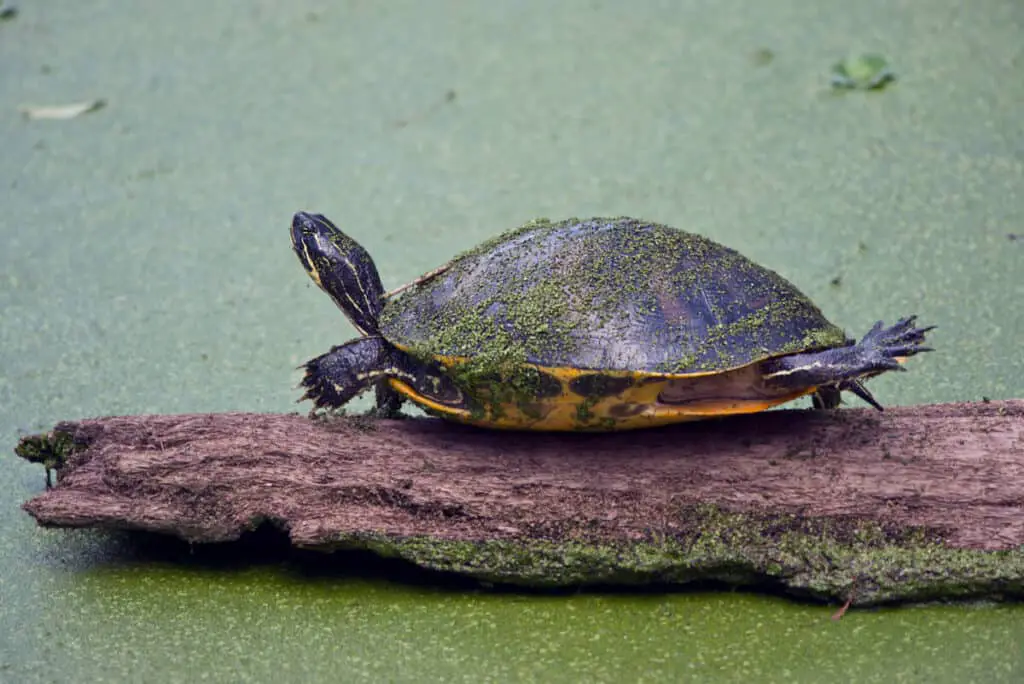
This turtle species has the biological name Pseudemys nelsoni. Its shell has a dome-like shape with a black or dark brown color.
The carapace has a few light-colored markings, while the plastron, from which the turtle gets the name redbelly, is red or at times orange in color and is more prominent in juveniles. Their skin is dark brown or black, just like the shell, and it has yellow stripes.
They have an average lifespan of 33 years and grow to a carapace length of between 8 and 14 inches.
Baby Florida redbelly turtles are omnivores mainly feeding on plants and insects. As they mature, they eat more plants, while mature ones are almost entirely fed on plants.
Florida redbelly turtles live in freshwaters as well as brackish waters. In Florida’s south-eastern part, they inhabit rivers, lakes, and ponds with plenty of aquatic vegetation. They avoid areas with sandy bottoms. It is common to see redbelly turtles basking on terrestrial parts close to their habitats.
This turtle breeds all year round, but the breeding season is primarily between May and July. Males reach reproduction maturity much faster at three years, while females become reproductive between six and eight years.
Females move to terrestrial nests to lay eggs, and a clutch often carries between 6 and 30 eggs. The incubation process takes around 75 days, and when hatchlings emerge, they measure about 1 inch only. As with most reptiles, redbelly turtles do not nurture their hatchlings.
Florida redbelly turtle is not considered a threatened species in Florida.
11. River Cooter Turtle
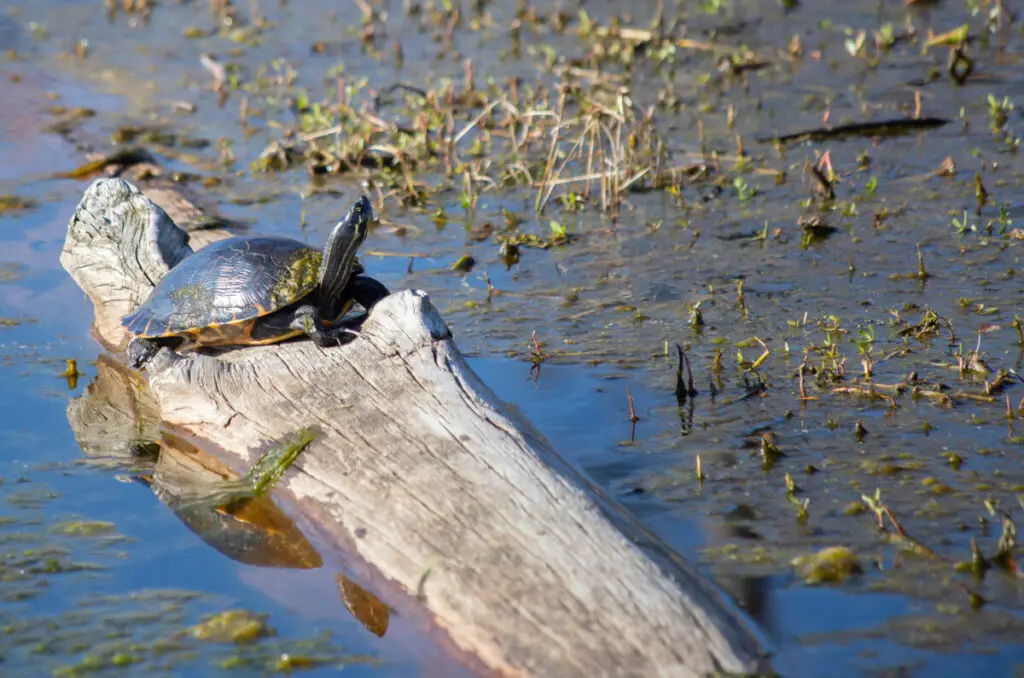
River Cooter is one of the most common and popular freshwater turtle species and has the biological name Pseudemys concinna. They are marked by having broadheads with several yellow stripes. River Cooter turtles can be distinguished from other Cooter turtles by the C-shaped marking on the second scute of each side of the carapace.
They have a flat, elongated shell with yellow, brown, and black markings. The shell is also streamlined for easier movement in waters and much flatter in males than in females. They have an orange, yellow or reddish plastron that has dark markings. In rare cases, the plastron margins are pink. Its head is dark with yellow to orange stripes.
This is another relatively large freshwater turtle in Florida. In general, they get to 12 inches long when grown, although there are rare cases where they get to 17 inches. Their lifespan is around 40 years in the wild.
River cooters often inhabit clear-flowering waters with beds of aquatic vegetation and cobble or gravel bottoms. Basking spots are also a key component of their habitat, although they sometimes move to banks to bask. They inhabit large streams and rivers.
In terms of reproduction, river cooter turtles nest between the end of April and early July. Females often lay an average of 16 eggs which remain in incubation for a minimum of 45 days and a maximum of 56. Hatchlings often overwinter in the nest.
River cooter turtles are of least conservation concern in Florida.
12. Florida Cooter Turtle
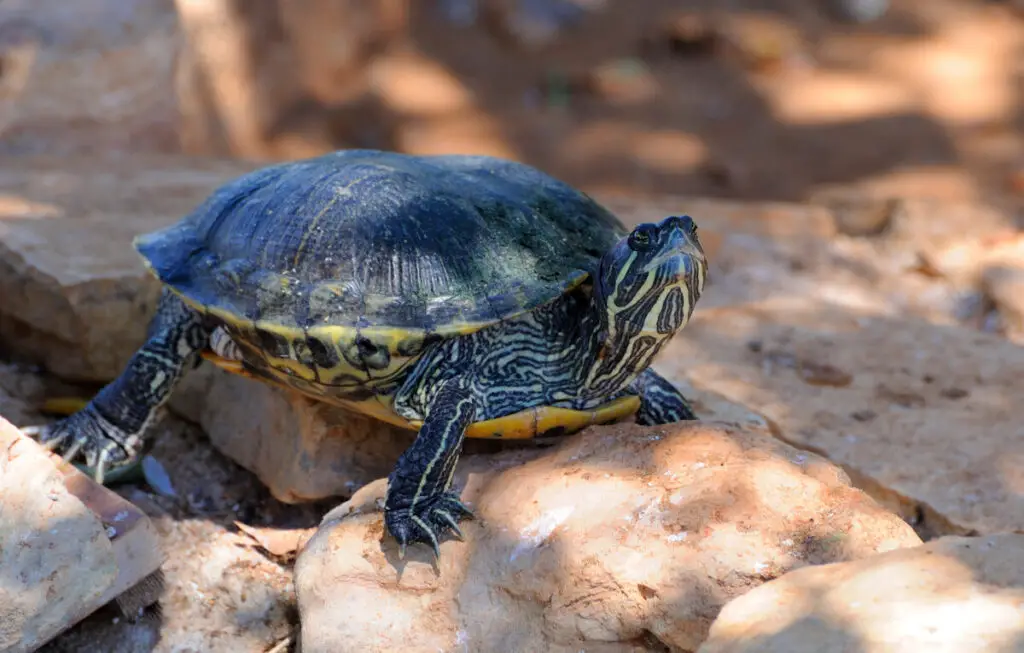
These are large turtle species as they grow to a shell length of up to 13 inches. They have flatter shells, almost resembling slider turtles. Their scientific name is Pseudemys floridana, and while some authorities consider them a subspecies of river cooter turtles, others consider them to be a full species.
Their carapace is darkly adorned with orange or yellow markings that are more visible in juveniles. The plastron is yellow and unmarked, while the marginal scutes have hollow-oval marks. Florida cooter turtle’s neck and head are also dark with yellow stripes.
Unlike river cooters, whose markings assume a net-like pattern, Florida Cooter turtles have vertical lines/stripes. Their average lifespan is 40 years.
Florida Cooters are fond of permanent waters with plenty of aquatic plants and soft sandy bottoms. They often inhabit swamps, lakes, marshes, slow-flowing rivers, and ponds. They also frequently bask in groups and are common in most parts of Florida.
This turtle species feeds on an omnivorous diet. They are opportunistic feeders, and the females mainly feed on aquatic plants while males eat aquatic invertebrates.
Breeding occurs from May to July. Female Florida Cooter turtles find suitable nesting areas, preferably on soft soils near water. Next, they dig cavities, then lay eggs and leave them to hatch on their own.
They lay a maximum of 2 clutches in a year, with each clutch often having an average of 20 eggs. Incubation takes an average of 3 months, although hatchlings may overwinter in the nest.
Florida Cooter is a turtle of the least concern in Florida.
13. Suwannee Cooter Turtle
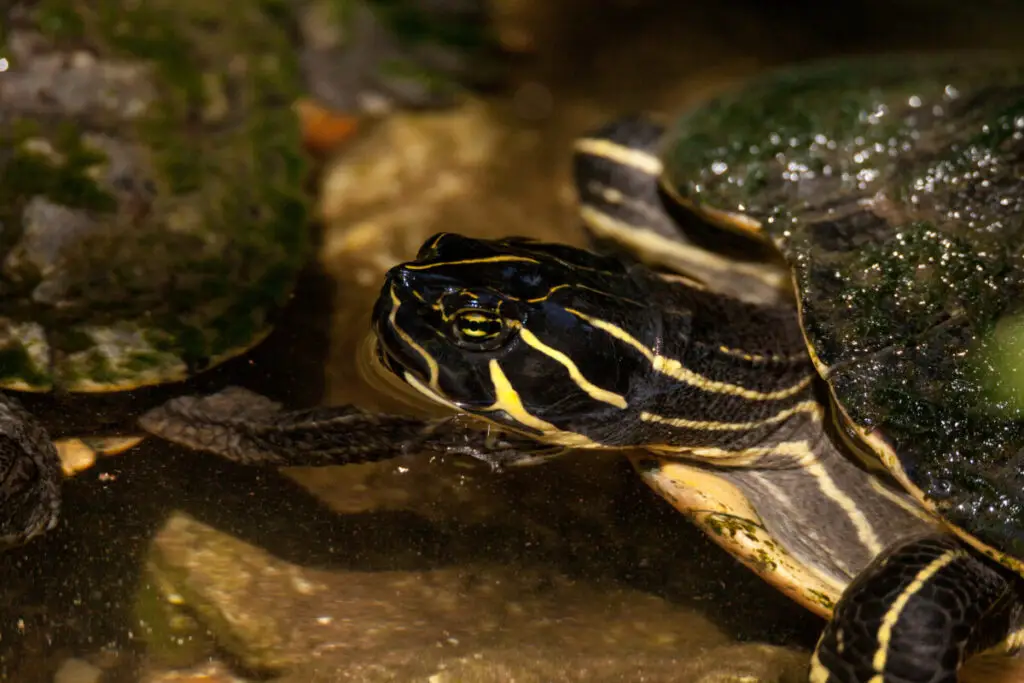
Their carapace is black with yellow marks while the is yellow or orange with black marks. On the other hand, their skin is green and has yellow lines that fade as they age. Their hind limbs are black, while the head and neck have yellow stripes like the rest of the skin. Suwannee cooter turtle’s scientific name is Pseudemys suwanniensis.
This is one of the largest Cooter turtles globally, with an upper shell length of around 17 inches. Their lifespan ranges between 20 and 40 years.
Their diet mainly comprises aquatic vegetation.
They are aquatic species whose habitats feature plenty of aquatic vegetation, basking surfaces, and moderately flowing water. These turtles inhabit both freshwater bodies and black waters. Suwannee cooter turtles hardly appear on land other than during nesting. They are common in the western part of Florida.
Females reach reproductive maturity between the age of nine to thirteen, while males mature between eight and ten years of age.
Nesting starts in March and ends in August, and females particularly look for areas with plenty of sunlight and well-drained to increase the chances of their eggs surviving. Their females lay approximately 20 eggs in a clutch, and they can lay as many as six clutches in a year. The eggs remain in incubation for an average of 85 days, after which hatchlings either emerge or overwinter in the nests.
Suwannee cooter turtles are not protected in Florida, although they face the threat of water pollution in their habitats.
Freshwater Turtle Rules and Regulations In Florida
Freshwater turtles face various threats such as water pollution, destruction of habitats, overharvesting, etc. This has led to some of these species being declared endangered, such as the Barbour’s Map. As such, there is a great need to put in measures to protect these species from becoming extinct.
Florida has some of the most comprehensive turtle laws in the US. Below, we get to have a look at these rules and regulations governing the trade, petting, and harvesting of freshwater turtles in Florida.
· Possession
Florida Fish & Wildlife Conservation Commission (FWC) prohibits one form possessing or taking a wild turtle, whether freshwater or not, listed as imperiled species from the wild. The freshwater turtles in the imperiled species list are Suwannee cooter and Barbour’s cooter turtles. The other in this list is the alligator snapping turtle.
The law also prohibits people from taking from the wild any turtle species that is similar to the imperiled turtle species. These are snapping turtles, Escambia map turtles, and cooter turtles.
For the rest of the freshwater turtle species, one can only take one turtle from the wild per day and not for commercial purposes. Besides taking, one is not allowed to transport more than one turtle in a day unless they have a wildlife exhibition license, sale license, or proof of purchase documentation.
Another freshwater regulation in Florida is that freshwater turtles can only be taken using a baited hook, dip net, hand, or using minnow seine. The use of firearms, snares, and bucket traps is prohibited. There is no regulation on when one can take a turtle for the permitted species as it is permitted all year round.
One can only take a maximum of two Escambia map turtle and their eggs. Other turtles whose possession in Florida is limited to a maximum of two are box turtles, diamond terrapins, and loggerhead musk species.
· Sale & Purchase
Buying, selling, and possession for sale of Suwanee cooter turtles, Barbour’s map turtle, or their parts is illegal in Florida. This law also applies to gopher tortoises and alligator snapping turtles.
Still on sale, it is illegal to sell any turtle taken from the wild.
· Release into The Wild
Florida laws prohibit the release of non-native turtles and any other non-native animal into the wild. This is because the release of non-native animals into the wild leads to competition on prey, habitat, and food with the native ones.
Red-eared sliders are a non-native species introduced into Florida through release by pet owners into the wild. Florida turtle laws prohibit people from keeping red-eared slider pets other than those who owned this turtle species prior to 1st July 2007.
Red-eared sliders are considered conditional turtle species in Florida, and those possessing or importing red-eared sliders for sale outside Florida, exhibition, or research need a permit.
Conclusion
We have covered the freshwater turtle species in Florida. It is clear that this state is rich in turtle diversity. Besides freshwater species, Florida is also home to sea and terrestrial species as well.
Some of the turtles in Florida are endangered species mainly due to water pollution, overharvesting, and the destruction of their habitats. Measures put in place by FWC be strictly adhered to to ensure that our beloved species do not become extinct.
Learn more about other turtle species:
- Turtles In Oklahoma (17 Species Guide)
- Turtles In Maryland (Full Guide With Pictures)
- Turtles In Alabama (30 Species with Pictures)
- Kentucky Native Turtles (17 Species With Pictures)
- Indiana Native Turtles (Ultimate Guide With Pictures)
- Michigan Native Turtles (10 Species with Pictures)
- 18 Native Turtles in Tennessee (Guide With Pictures)
- Common Turtles Species in Massachusetts
- Turtles In South Carolina (20 Species With Pictures)